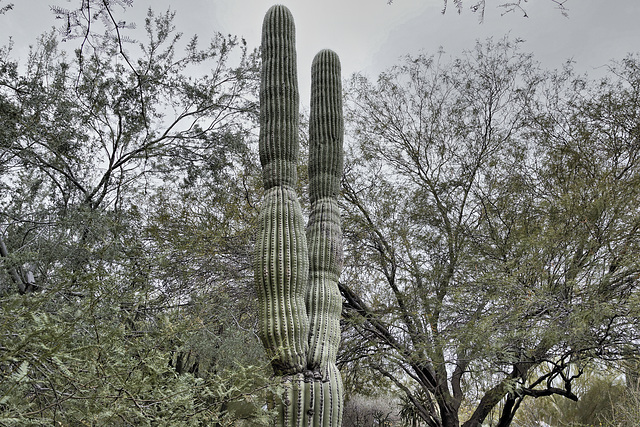Jonathan Cohen's photos
Low Hanging Fruit – Desert Botanical Garden, Papago Park, Phoenix, Arizona
Hodgepodge – Desert Botanical Garden, Papago Park, Phoenix, Arizona
The Fickle Finger of Fate – Desert Botanical Garden, Papago Park, Phoenix, Arizona
Saguaro Cactus – Desert Botanical Garden, Papago Park, Phoenix, Arizona
The saguaro cactus (Carnegiea gigantea) is one of the defining plants of the Sonoran Desert. Indeed, they are found almost exclusively in the Sonoran Desert. The most important factors for their growth are water and temperature. If the elevation is too high, the cold weather and frost can kill the saguaro. Although the the Sonoran Desert experiences both winter and summer rains, it is thought that the Saguaro obtains most of its moisture during the summer rainy season.
These plants are large, tree-like columnar cacti that develop branches (or arms) as they age, although some never grow arms. These arms generally bend upward and can number over 25. Saguaros are covered with protective spines, white flowers in the late spring, and red fruit in summer.
Although the saguaro is the largest cactus in the United States, it grows very slowly. A 10 year old plant might only be 1.5 inches tall. Saguaro can grow to be between 40-60 feet tall (12-18m). Most of the saguaros roots are only 4-6 inches deep and radiate out as far from the plant as it is tall. There is one deep root, or tap root that extends down into the ground more than 2 feet. When rain is plentiful and the saguaro is fully hydrated it can weigh between 3200-4800 pounds. With the right growing conditions, it is estimated that saguaros can live to be as much as 150-200 years old. After the saguaro dies its woody ribs can be used to build roofs, fences, and parts of furniture. The holes that birds nested in or "saguaro boots" can be found among the dead saguaros. Native Americans used these as water containers long before the canteen was available.
Neatly Nested – Desert Botanical Garden, Papago Park, Phoenix, Arizona
Cactus Fruit, #3 – Desert Botanical Garden, Papago Park, Phoenix, Arizona
Cactus Fruit, #2 – Desert Botanical Garden, Papago Park, Phoenix, Arizona
Cactus Fruit, #1 – Desert Botanical Garden, Papago Park, Phoenix, Arizona
A Prickly Inukshuk – Desert Botanical Garden, Papago Park, Phoenix, Arizona
Cylindropuntia spinosior, with the common names include cane cholla, spiny cholla and walkingstick cactus, is a cactus species of the North American deserts. It is native to Arizona and New Mexico in the United States; and Chihuahua and Sonora in Mexico. In Australia, the species is regarded as an emerging weed threat where it is known as snake cactus. It is a declared noxious weed in New South Wales where it was first observed in 2000/2001. It is also naturalized in South Australia and Queensland.
Cylindropuntia spinosior grows to between 0.4 and 1.2 metres in height and has spine-covered stems. Flowers may be rose, red purple, yellow, or white and appear from spring to early summer. These are followed by fruits that are yellow with occasional red or purple tinges.
Inukshuk (also spelled inuksuk, plural inuksuit) is a figure made of piled stones or boulders constructed to communicate with humans throughout the Arctic. Inuksuit have been found adjacent to archaeological sites dating from 2400 to 1800 BCE in the Mingo Lake region of southwest Baffin Island. Inuksuit are placed throughout the Arctic landscape acting as "helpers" to the Inuit. Among their many practical functions, they are used as hunting and navigational aids, coordination points and message centres (e.g., they might indicate where food was cached). In addition to their earthly functions, certain inuksuk-like figures have spiritual connotations, and are objects of veneration, often marking the spiritual landscape of the Inummariit – the Inuit who know how to survive on the land living in their traditional way.
The Inuit also construct a stone figure called an inunnguaq, which means "in the likeness of a human." This familiar stone figure with head, body, legs and arms is often mistakenly referred to as an inuksuk. Its purpose is more symbolic than functional. Because of its humanoid appearance in the likeness of a little person, its image has become a popular cross-cultural symbol.
Jump to top
- ipernity © 2007-2025
- Help & Contact
|
Club news
|
About ipernity
|
History |
ipernity Club & Prices |
Guide of good conduct
Donate | Group guidelines | Privacy policy | Terms of use | Statutes | In memoria -
Facebook
Twitter










